When I arrived in Panama, it was dark. I couldn't see Panama City when I landed or any of the terrain as the driver took me to Canopy Lodge. Had I not been so exhausted from travel, the sound of running water, frogs and wind would have forced my brain awake, so much of the surrounding terrain was hidden from me and I couldn't wait to see it. Then I woke up the next morning. The wind was really howling, I felt that I had arrived in a strange and mysterious land. I couldn't help but enjoy the nighttime chorus. In Minnesota, February nights are mostly silent (apart from the occasional owl), there no leaves rustling in wind, no running water, no frogs and crickets singing.

The next morning I was roused awake by a very loud and squeaky hummingbird outside my window, I looked out to the above view. The lodge is tucked in the forest surrounded by mountains. It was humid and it took some time for my body to adjust, but because of the elevation, the temperatures were not overwhelmingly hot. Everything smells warm and wet. The schedule at Canopy Lodge is a dream: breakfast, field trip, lunch, siesta, field trip, and dinner followed by some conversation--a very relaxing pace.

Everything at the lodge is built for luxurious comfort in the open air. The library and dining area is on a large porch area, you can watch birds and wildlife any time that you want. Since I arrived so late at night, the owner--Raúl Arias de Para let me sleep in my first day. Breakfast was waiting for me when I stepped out and right away, foraging on the ground next to the library was a rufous motmot to greet me. The bird perched there most of the time. Alas, it was too dark for a photo, but I was able to get some video of the cool looking bird:
[youtube]http://www.youtube.com/watch?v=Dqva3TgeYx4[/youtube]
I thought about my Guatemala trip last year and how hard it was to see a motmot--mine were pretty much all by ear or dim glimpses. This bird seemed a silent sentry of the lodge.

After breakfast I was free to watch the birds at the feeder which worked out well for me. When I'm in a new place, it's overwhelming, new birds everywhere! I have to check every single one to make sure I'm not missing anything. The very active bird feeders satiated that need. I sat in a deck chair and watched the "common" birds like broad-billed euphonia (the little blue and yellow guys) and blue-gray tanagers swarm into the feeder. The feeders were simply filled with bananas and the staff kept a close eye out and replaced them regularly.

I especially loved the large chestnut-headed oropendolas that fly in to the feeders. What an amazing looking bird--that giant beak, the subtle green on the wings, the yellow on the tail, and that lovely little blue eye, they make strange almost mechanical sounds. So I took some time to just enjoy the activity. The one thing about Canopy Lodge--it is definitely a birder's lodge. I have a tendency to sleep out of pajamas in warm weather and lounge about that way in the morning. Not thinking, I had most of the curtains open to keep an eye out for birds...I ended up seeing quite a few birders wandering the property (who were far more interested in birds than my open windows) and wearing pajamas to bed.

And what a place to wander! There's a creek right outside the lodge (you can hear it in the background of the motmot video above). The creek had birds flitting all over including green kingfishers and...

...this very exciting sunbittern! I only saw it in low light and this was the best photo I could get of this bird. Sunbitterns are cool looking birds that eat fish and invertebrates but they do this wild display with their wings. I've read that it is used in courtship displays and to frighten off potential predators.

In the middle of the day, you could find lizards sunning themselves on the rocks in the creek. This was a large male basiliscus we found on a rock. This lizard is also known as "the Jesus Lizard" because the young basiliscus appears to walk on water. It's more of a wild flailing of limbs and tails that makes it look like the lizard walks across the water. It's not majestic, but if you don't know they are there and they take off, it's startling--especially the larger lizards who splash through the water, rather than zip across the top.

The grounds are beautiful and as I meandered watching the various tanagers, I was surprised to find this huge and beautiful tree house. Raúl told me that he had built for his children and they would play and sometimes spend the night in the house. You can still go up in the tree house, but it is required that a member of the staff accompany you to the top for safety reasons. I imagines what a wonderful childhood it would be to have this huge tree house in the top of the rain forest to play and grow up in, oh the things you would see and the adventures you would have. Under the tree house is a pond with ropes draped overhead to allow you to swing and cool off in the water which at least one person took advantage of during our stay.

I could not get enough of this bird. It's a crimson-back tanager. I didn't think red got much better than a scarlet tanager, but this bird demanded that I reconsider that idea. I don't think any photo can truly do the red of this bird justice. The beak is silver, the bottom mandible huge. I couldn't believe this bird would readily fly in for bananas, but it did. My favorite moment of my first day was sitting in the deck chairs with my coffee (dusted with a bit of cocoa), feeling a cool breeze across my face and staring at the many, many crimson-backed tanagers. This is a bird I saw several times in Panama, but never did I have as good of looks at the crimson-backed as I did at the Lodge. What a treat to be able to drink in the colors. This is another one of those birds who make me wish I could paint. I would love to spend a few hours drawing this bird, getting to know every nook and cranny of every feather.
More Canopy Birding to come.


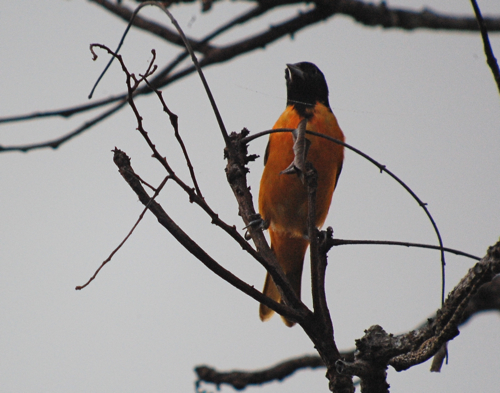
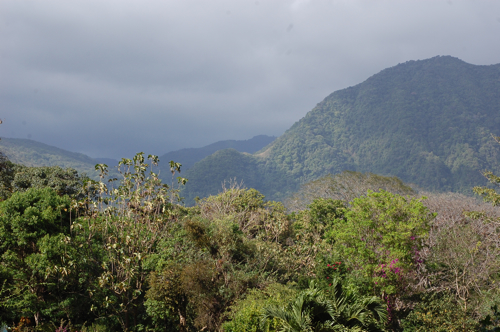
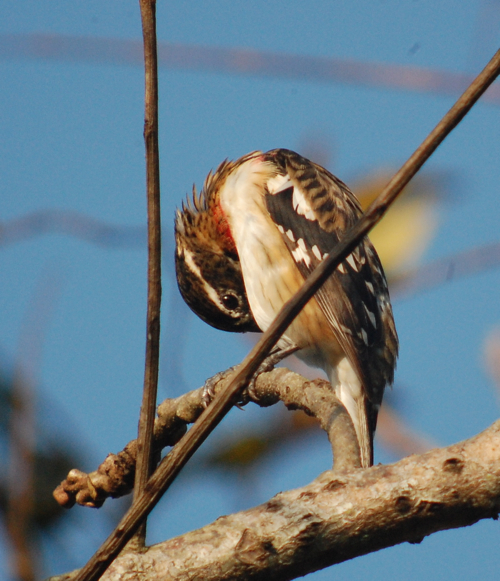
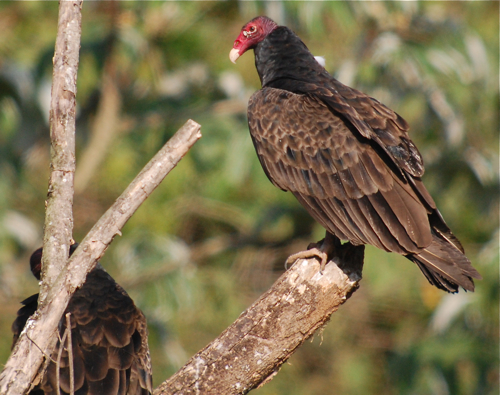
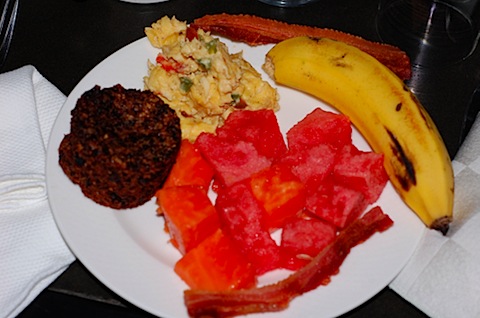 I look out my apartment window this morning at the new snow cover taking note of the new parking restrictions in my neighborhood (no parking on the even side of the streets until April 1 or some significant snow melt happens). Sigh, not so long ago, I was in Panama, starting my morning with fresh bananas, papaya and watermelon (there was also fresh pineapple but I can't eat that). A little bacon, some eggs, a weird banana bran muffin and a tangy little picante sauce.
I look out my apartment window this morning at the new snow cover taking note of the new parking restrictions in my neighborhood (no parking on the even side of the streets until April 1 or some significant snow melt happens). Sigh, not so long ago, I was in Panama, starting my morning with fresh bananas, papaya and watermelon (there was also fresh pineapple but I can't eat that). A little bacon, some eggs, a weird banana bran muffin and a tangy little picante sauce.
















